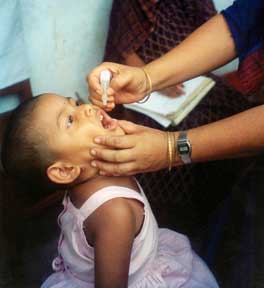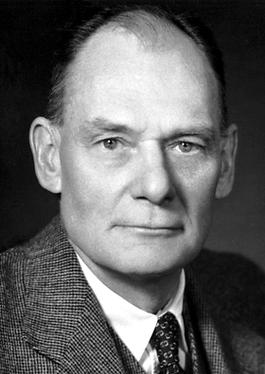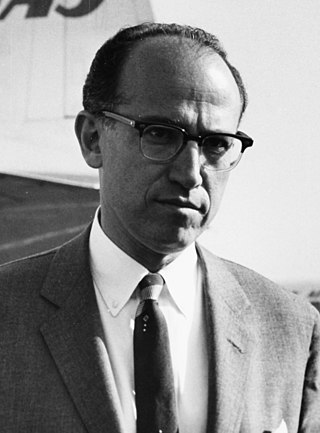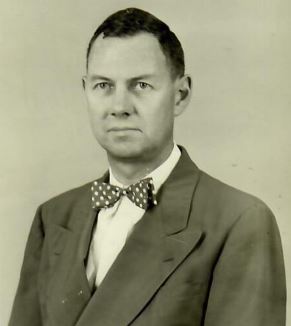This article includes a list of references, related reading, or external links, but its sources remain unclear because it lacks inline citations .(April 2009) |
Percival Landon Bazeley CBE was a scientist of Australian biotechnology and public health.
This article includes a list of references, related reading, or external links, but its sources remain unclear because it lacks inline citations .(April 2009) |
Percival Landon Bazeley CBE was a scientist of Australian biotechnology and public health.
Born in Orbost, Victoria, Australia on 2 March 1909, Bazeley attended the school of Veterinary Science at the University of Sydney, graduating in 1938. During his course of study, he undertook employment at Australia's Commonwealth Serum Laboratories during vacation periods. Subsequently, he joined CSL on a full-time basis in 1939. Val Bazeley joined the Australian Army Militia in June 1939, and began full-time military service in the Australian Imperial Force on 23 May 1941.
With the discovery and subsequent large-scale production of the wonder drug penicillin, a project for the production of penicillin in Australia became a high priority defence need. Captain Bazeley was brought back from New Guinea, where he was a captain in the 2/8th Australian Armoured Regiment, to head the team given the task of producing penicillin. Dr. Bazeley visited the United States and returned to set up production at CSL. In the face of great difficulties, given wartime conditions, his personal contribution to the success of the project cannot be underestimated. He was a driving force and spent long hours at the laboratories grappling with the problems of the new venture. By Christmas of 1943, the first Australian penicillin had arrived in New Guinea to save countless lives. In the months to follow, enormous quantities of penicillin were produced in the primitive CSL plant, and Australia can boast of being the first country in the world to have had penicillin available for its civilian population, having met not only the needs of its own defence forces, but also those of the American allies in the southwest Pacific.
It was during this period that Captain Bazeley's promotion as Major occurred, and the familiar black beret of the Armoured Corps was replaced by the Major's peaked cap.
With the end of the war, Val Bazeley returned to university studies, and graduated as MB BS (Bachelor of Medicine, Bachelor of Surgery) from the University of Melbourne in 1950. By then, he had received the O.B.E. (Order of the British Empire) for his work on penicillin.
The early 1950s saw Dr. Bazeley at the University of Pittsburgh in the United States working with Jonas Salk and his team towards the production of a Poliomyelitis vaccine. With the success of that project, he returned to Australia to once again find himself given the task of pioneering the production of an important new weapon against disease. Twenty-five million doses of Salk Poliomyelitis vaccine were produced at CSL in the 1950s and 1960s under Dr. Bazeley's leadership as director of the government institution. This led to widespread recognition. He was awarded a C.B.E. (Commander of the Order of the British Empire) and was deservedly renowned in the general community where, for example, he was chosen as Victorian Father of the Year in 1958.
In 1961, Dr. Bazeley returned to the United States to work with Jonas Salk at the Salk Institute in La Jolla, California. Subsequently, he joined UC San Diego's University Hospital (now "UCSD Medical Center") as a full professor of medicine. At this same time, he also personally funded and maintained a private medical research facility outside Salt Lake City, Utah. University of California mandatory retirement rules forced Dr. Bazeley into private medical practice at the age of 67. He died 10 September 1991.

Polio vaccines are vaccines used to prevent poliomyelitis (polio). Two types are used: an inactivated poliovirus given by injection (IPV) and a weakened poliovirus given by mouth (OPV). The World Health Organization (WHO) recommends all children be fully vaccinated against polio. The two vaccines have eliminated polio from most of the world, and reduced the number of cases reported each year from an estimated 350,000 in 1988 to 33 in 2018.

John Franklin Enders was an American biomedical scientist and Nobel Laureate. Enders has been called "The Father of Modern Vaccines."

Albert Bruce Sabin was a Polish-American medical researcher, best known for developing the oral polio vaccine, which has played a key role in nearly eradicating the disease. In 1969–72, he served as the president of the Weizmann Institute of Science in Israel.
Joseph Edward Smadel (1907–1963) was a U.S. medical doctor and virologist. He introduced chloramphenicol as treatment for rickettsial diseases. In 1962, he became the first recipient of the Albert Lasker Award for Clinical Medical Research.

CSL Limited is an Australian multinational specialty biotechnology company that researches, develops, manufactures, and markets products to treat and prevent serious human medical conditions. CSL's product areas include blood plasma derivatives, vaccines, antivenom, and cell culture reagents used in various medical and genetic research and manufacturing applications. The company was established in 1916 as Commonwealth Serum Laboratories and was wholly owned by the Australian federal government until its privatisation in 1994.

Herald Rea Cox (1907–1986) was an American bacteriologist. The bacterial family Coxiellaceae and the genus Coxiella, which include the organism that causes Q fever, are named after him.

Parke-Davis is a subsidiary of the pharmaceutical company Pfizer. Although Parke, Davis & Co. is no longer an independent corporation, it was once America's oldest and largest drug maker, and played an important role in medical history. In 1970 Parke-Davis was acquired by Warner-Lambert, which in turn was acquired by Pfizer in 2000.

Thomas Francis Jr. was an American physician, virologist, and epidemiologist who guided the discovery and development of the polio vaccine being worked on by his student Jonas Salk. Francis was the first person to isolate influenza virus in the United States, and in 1940 showed that there are other strains of influenza, and took part in the development of influenza vaccines.
Cutter Laboratories was a family-owned pharmaceutical company located in Berkeley, California, founded by Edward Ahern Cutter in 1897. Cutter's early products included anthrax vaccine, hog cholera virus, and anti-hog cholera serum—and eventually a hog cholera vaccine. The hog cholera vaccine was the first tissue culture vaccine, human or veterinary, ever produced. The company expanded considerably during World War II as a consequence of government contracts for blood plasma and penicillin. After Edward Cutter's death, his three sons—Dr. Robert K. Cutter (president), Edward "Ted" A. Cutter Jr. (vice-president), and Frederick A. Cutter—ran the company. In the next generation Robert's son David followed his father as president of the company. The Bayer pharmaceutical company bought Cutter Laboratories in 1974.

The history of polio (poliomyelitis) infections began during prehistory. Although major polio epidemics were unknown before the 20th century, the disease has caused paralysis and death for much of human history. Over millennia, polio survived quietly as an endemic pathogen until the 1900s when major epidemics began to occur in Europe. Soon after, widespread epidemics appeared in the rest of the world. By 1910, frequent epidemics became regular events throughout the developed world primarily in cities during the summer months. At its peak in the 1940s and 1950s, polio would paralyze or kill over half a million people worldwide every year.

CSL Behring is a biopharmaceutical company, manufacturing plasma-derived, and recombination therapeutic products. The company is a combination of Behringwerke, founded in 1904 in Marburg, Germany by Emil von Behring, and the Commonwealth Serum Laboratories (CSL), established in Australia in 1916 to provide vaccines to the people of Australia, as well as other companies acquired since 2004

Isabel Merrick Morgan was an American virologist at Johns Hopkins University, who prepared an experimental vaccine that protected monkeys against polio in a research team with David Bodian and Howard A. Howe. Their research led to the identification of three distinct serotypes of poliovirus, all of which must be incorporated for a vaccine to provide complete immunity from poliomyelitis. Morgan was the first to successfully use a killed-virus for polio inoculation in monkeys. After she married in 1949, she left the field of polio research in part because she was uncomfortable with trials that tested polio vaccines on the nerve tissue of children. She then worked on epidemiological studies on air pollution. Later in life, she was a consultant for studies of cancer therapies at the Sloan-Kettering Cancer Institute.
Mikhail Petrovich Chumakov was a Soviet microbiologist and virologist most famous for conducting pivotal large-scale clinical trials that led to licensing of the Oral Polio Vaccine (OPV) developed by Albert B. Sabin.

Jonas Edward Salk was an American virologist and medical researcher who developed one of the first successful polio vaccines. He was born in New York City and attended the City College of New York and New York University School of Medicine.

Biomedical sciences are a set of sciences applying portions of natural science or formal science, or both, to develop knowledge, interventions, or technology that are of use in healthcare or public health. Such disciplines as medical microbiology, clinical virology, clinical epidemiology, genetic epidemiology, and biomedical engineering are medical sciences. In explaining physiological mechanisms operating in pathological processes, however, pathophysiology can be regarded as basic science.

Howard Atkinson Howe was an American physician, whose work at the Johns Hopkins medical institutions helped to lay the groundwork for the Salk polio vaccine.
Herdis von Magnus was a Danish virologist and polio expert. After working with Jonas Salk, she and her husband directed the first polio vaccination program in Denmark. She also researched encephalitis.
Leone Norwood Farrell (1904–1986) was a Canadian biochemist and microbiologist who identified microbial strains of industrial importance and developed innovative techniques for the manufacture of vaccines and antibiotics. Her inventions enabled the mass production of the polio vaccine.

The announcement of the polio vaccine's safety and effectiveness was on April 12, 1955, by Dr. Thomas Francis, Jr., of the University of Michigan, the monitor of the test results. Within minutes of his announcement to the audience of scientists and reporters, news of the event was carried coast to coast by wire services and radio and television newscasts. When the vaccine was announced as successful, therefore, it led to spontaneous celebrations across the United States. It was the world's first successful polio vaccine, declared “safe, effective, and potent.” It was possibly the most significant biomedical advance of the past century.

Colonel Esmond Venner (Bill) Keogh, was an Australian physician, medical scientist, and army officer who was instrumental in saving thousands of lives from tuberculosis, polio, cancer and other diseases.